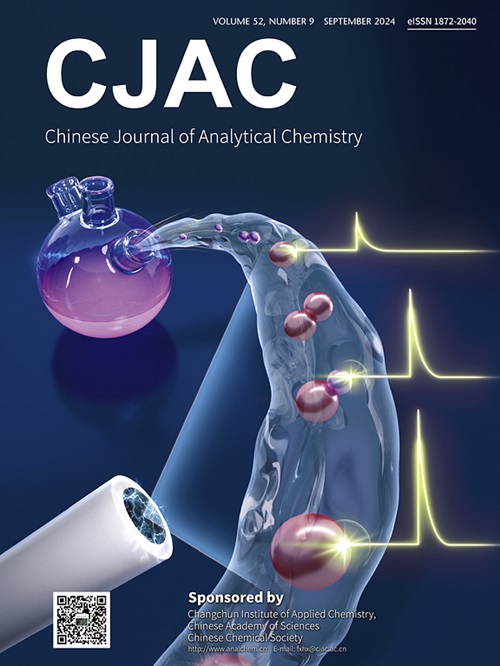Steric and energetic studies on the retention of Cd (II) and Zn (II) metal ions into magnesium rich zeolite-A synthesized from natural talc: Experimental and theoretical studies
IF 1.3
4区 化学
Q4 CHEMISTRY, ANALYTICAL
引用次数: 0
Abstract
Magnesium-rich zeolite-A (Mg.ZA) was successfully synthesized from natural talc minerals as a novel form of magnesium silicate zeolitic structure with a surface area of 187 m2/g and mesoporous nature (1.5 to 10 nm). Different characterization techniques, including X-ray diffraction (XRD), fourier transform infrared spectroscopy (FT-IR), energy dispersive X-ray spectroscopy (EDX), scanning electron microscope (SEM), and Brunner−Emmet−Teller (BET), confirmed the formation of Mg.ZA. The adsorption properties of Mg.ZA were evaluated for effective retention of toxic Cd (II) and Zn (II) metallic ions from the water supplies. The Mg.ZA structure displays significant capacities for the two ions, with saturation capacities (278 mg/g (Cd (II)) and 221.2 mg/g (Zn (II)) higher than several investigated adsorbents. Based on the steric analysis of the applied advanced isotherm models, the structure of Mg.ZA was enriched in 150 and 106.9 mg/g effective uptake sites during the retention of Cd (II) and Zn (II), respectively. Up to three ions of Cd (II) and Zn (II) can occupy each of these sites, contributing to their adsorption in a vertical orientation through multi-interaction or multi-ionic mechanisms. The energetic assessment, either based on Gaussian energy (< 7 kJ/mol) or adsorption energy (< 6 kJ/mol), suggested the predominant impact of physical mechanisms (hydrogen bonds and electrostatic attraction), in addition to the impact of the zeolitic ion exchange process (0.6 to 25 kJ/mol). Furthermore, the thermodynamic functions declare the retention of these ions into the framework of Mg.ZA by exothermic and spontaneous reactions.

天然滑石合成的富镁沸石a中Cd (II)和Zn (II)金属离子保留的空间位能研究:实验和理论研究
富镁沸石a (Mg.ZA)是一种新型的镁硅酸盐沸石结构,具有介孔性质(1.5 ~ 10 nm),比表面积为187 m2/g。不同的表征技术,包括x射线衍射(XRD)、傅里叶变换红外光谱(FT-IR)、能量色散x射线光谱(EDX)、扫描电子显微镜(SEM)和Brunner - Emmet - Teller (BET),证实了Mg.ZA的形成。镁的吸附性能。评估了ZA对水中有毒Cd (II)和Zn (II)金属离子的有效保留。Mg。ZA结构对两种离子表现出显著的吸附能力,其饱和容量(278 mg/g (Cd (II))和221.2 mg/g (Zn (II))高于几种所研究的吸附剂。基于已应用的先进等温线模型的立体分析,研究了镁合金的结构。在Cd (II)和Zn (II)滞留过程中,ZA分别富集于150和106.9 mg/g有效摄取位点。Cd (II)和Zn (II)离子最多可以占据三个位点,通过多相互作用或多离子机制在垂直方向上吸附它们。能量评估,要么基于高斯能量(<;7kj /mol)或吸附能(<;6 kJ/mol),表明除了沸石离子交换过程(0.6 ~ 25 kJ/mol)的影响外,物理机制(氢键和静电吸引)也是主要的影响因素。此外,热力学函数表明这些离子保留在Mg的框架内。放热反应和自发反应。
本文章由计算机程序翻译,如有差异,请以英文原文为准。
求助全文
约1分钟内获得全文
求助全文
来源期刊
CiteScore
3.60
自引率
25.00%
发文量
17223
审稿时长
35 days
期刊介绍:
Chinese Journal of Analytical Chemistry(CJAC) is an academic journal of analytical chemistry established in 1972 and sponsored by the Chinese Chemical Society and Changchun Institute of Applied Chemistry, Chinese Academy of Sciences. Its objectives are to report the original scientific research achievements and review the recent development of analytical chemistry in all areas. The journal sets up 5 columns including Research Papers, Research Notes, Experimental Technique and Instrument, Review and Progress and Summary Accounts. The journal published monthly in Chinese language. A detailed abstract, keywords and the titles of figures and tables are provided in English, except column of Summary Accounts. Prof. Wang Erkang, an outstanding analytical chemist, academician of Chinese Academy of Sciences & Third World Academy of Sciences, holds the post of the Editor-in-chief.

 求助内容:
求助内容: 应助结果提醒方式:
应助结果提醒方式:


